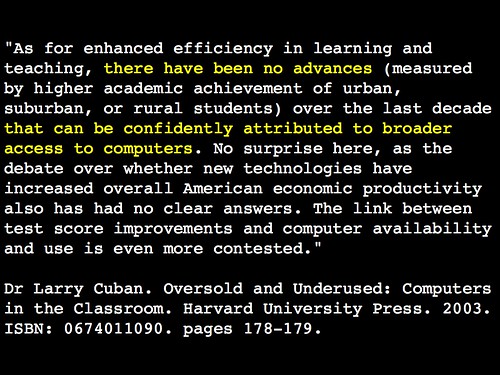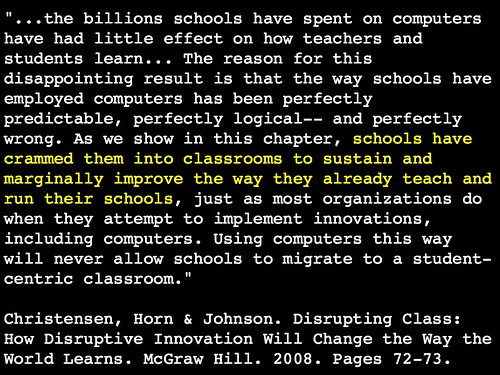According to the SMART Technologies press release “SMART’s 2008 sales more than double its nearest competition” from 13 February 2009:
Futuresource noted that 557,000 interactive whiteboards were shipped in 2008, a 32 percent increase over 2007. More than two million interactive whiteboards are now installed worldwide, and the product category continues to exhibit strong growth. Futuresource forecasts that the global installed base will triple over the next five years to more than seven million. The consulting firm also predicts that one out of every five classrooms worldwide will have an interactive whiteboard by the end of 2013.
I have mixed feelings about these reported trends.
On the one hand, I think it is great more classrooms and classroom teachers are being empowered to utilize digital technologies and digital content in lessons with students. I remember how shocked I was in August of 2001 when I started work at the College of Education at Texas Tech University. At that point we were still in the “old” administration building, and only ONE classroom had an LCD projector mounted in it for regular faculty use. There was not ANY WiFi available in the building at all, and many classrooms did not have Internet “drops” either. When I wanted to use the Internet in those rooms, I had to bring my own WiFi access point from home and connect it in a nearby room. Even when we moved to our “new” building, less than half the classrooms were equipped with LCD projectors. All of the classrooms had overhead projectors, however! As Dr. Alan Kay has observed, “The predominant technology determines the predominant learning task” in the classroom.” When overhead projectors predominate in classrooms instead of LCD projectors, guess what kind of technology gets used to share information with students?

![]() photo credit: designer-wg.de
photo credit: designer-wg.de
Most Sundays when I teach 5th graders at our church, I REALLY enjoy and appreciate the opportunity to utilize the ONE SMARTboard / electronic whiteboard we have in the entire building. Thankfully, it’s not in demand by other teachers at this point. If it was, it’s doubtful I’d be able to reserve and use it almost EVERY Sunday. When I am teaching and presenting material, I feel severely handicapped at this point if I’m not able to use a computer and a projector to share photographs, videos, and readily query the web for answers I may not know or supplementary content I want to share with students which I didn’t obtain in advance of the lesson. I consider a computer and data projector ESSENTIALS in my classroom, and while I certainly can and do (at times) teach without them, those days are rare.
The other side of the whiteboard sales statistics cited above regard student laptops, however. I firmly believe 1:1 computing is the future of education and learning. As time continues to progress and price points for laptop and handheld computing technologies continue to fall, it simply will not make fiscal sense for schools to continue purchasing printed textbooks. (This is true in the U.S. When I visited New Zealand last month, I learned not all countries purchase textbooks for students.) Education budgets in our schools are zero sum. Sadly, in many U.S. districts today facing the realities of the recession, almost every line item is potentially on the “chopping block” EXCEPT athletics. We are facing some bleak, economic times, but even without the recession the need to embrace 1:1 learning and provide all students in grades 3 and above with a wireless, mobile computing device is essential.
What is the total cost of the 557,000 electronic whiteboards which were shipped in 2008 worldwide? How many OLPCs would that same sum of money have purchased?
As citizens of the United States await the disbursement this summer of half the expected 2009-2010 EETT funds (totaling somewhere around $750 million in all by year’s end) as taxpayers and citizens we should be asking some hard questions about how these dollars will be spent. Consider the following two quotations from my opening keynote address at eTechOhio on February 2, 2009. (I’ll also paste in the text in case you’re reading this on a device or network which isn’t showing you images.)
“As for enhanced efficiency in learning and teaching, there have been no advances (measured by higher academic achievement of urban, suburban, or rural students) over the last decade that can be confidently attributed to broader access to computers. No surprise here, as the debate over whether new technologies have increased overall American economic productivity also has had no clear answers. The link between test score improvements and computer availability and use is even more contested.”
Dr Larry Cuban. Oversold and Underused: Computers in the Classroom. Harvard University Press. 2003. ISBN: 0674011090. pages 178-179.
“…the billions schools have spent on computers have had little effect on how teachers and students learn… The reason for this disappointing result is that the way schools have employed computers has been perfectly predictable, perfectly logical– and perfectly wrong. As we show in this chapter, schools have crammed them into classrooms to sustain and marginally improve the way they already teach and run their schools, just as most organizations do when they attempt to implement innovations, including computers. Using computers this way will never allow schools to migrate to a student-centric classroom.”
Christensen, Horn & Johnson. Disrupting Class: How Disruptive Innovation Will Change the Way the World Learns. McGraw Hill. 2008. Pages 72-73.
The takeaway here is that improving student learning outcomes is all about HOW we use the tools at our fingertips. We do NOT need to simply “cram” (to use the parlance of Christensen, Horn and Johnson) more computer technology into our classrooms. We need to constructively disrupt the predominant learning paradigm in our schools. Advancing thoughtful, well-planned 1:1 learning initiatives focused on student centered learning, inquiry, and ongoing, differentiated means of assessment is perhaps the best way states can spend forthcoming EETT dollars in the coming school year.
Technorati Tags:
technology, school, eett, stimulus, politics, whiteboard, smart, electronic, laptop, 1to1, learning, leadership




Comments
5 responses to “Just how many electronic whiteboards are school leaders buying?”
In rural communities a SMARTboard in the classroom is a giant leap toward education for the 21st century. The digital divide is so great in many schools that 1:1 really isn’t a realistic possibility, yet. There is simply not the staff or access to training to support successful 1:1 programs. It is very difficult to add laptops when the entire school is sharing a T1.
Also, interactive whiteboards just used as electronic blackboards and using the same “sage on the stage” model does not provide real change. Teachers and students must both be trained to use the technology and engage in the interacting. If students are left in their seats to watch the teacher, a computer and projector is enough.
When used properly, an interactive whiteboard can be a powerful learning tool for students and a powerful instructional tool for the teacher. Unfortunately, most school districts see interactive whiteboards as a “solution” to their lack of ICT in classrooms and teachers are equally seduced by the possibilities a Smartboard may provide. However, most school districts don’t realize the costs associated with the interactive white board (data projector, mounting on the wall or portable cart)especially the professional learning the teacher must receive so that it does not become a glorified whiteboard that only the teacher uses.
In my jurisdiction, Manitoba, there is a similar explosion in the number of whiteboards appearing in classrooms. I wish there was a similar explosion in the number of netbooks in each classroom. I know that the students would actually touch and benefit from having 5-10 netbooks in the classroom as they move through the inquiry process. I am not so sure that most students, in a smartboard-equipped classroom, actually use the Smartboard. It is most often used as a teacher-focused piece of ICT.
Wesley,
I, too, share your concerns about technologies that tend to reinforce teacher-centered instruction. And IMHO, the Smartboard seems to fall into this category.
I ran across this quote a while back that shed some light (at least for me) on how entrenched teacher-centered instruction is:
“Why is it, in spite of the fact that teaching by pouring in, learning by a passive absorption, are universally condemned, that they are still so entrenched in practice? That education is not an affair of “telling” and being told, but an active and constructive process, is a principle almost as generally violated in practice as conceded in theory.”
This quote is from Dewey’s Democracy and Education – published in 1916!
What will it take for the schools to move toward student-centered learning? Probably a technology that is truly disruptive of normal “school” practices. It’ll probably be banned!
Regards,
Kent
It all depends on how the whiteboard is used for instruction. It is a process of moving from instructional technology to one of true technology integration. I see the Whiteboard or Interwrite Tablet as a step toward getting teachers to technology integration. With the interactive whiteboard it is not difficult for teachers to progress to collaborative learning right in the classroom. It is actually a powerful opportunity to model digital citizenship with students. There are possibly other ways to achieve this, but without a one-to-one initiative, a large screen with a presentation or video created by a student on the screen that we can then collectively comment on through voicethread or slideshare is a pretty good interim solution.
Dan
We are back again to training the teacher and time. How can teachers integrate the Interactive Whiteboard in the classroom? Curriculum is not designed for the these devices. I am afraid that like the 32″ televisions the projector and smartboard are destined to be obsolete in just a few years.